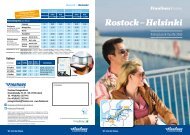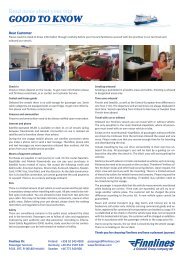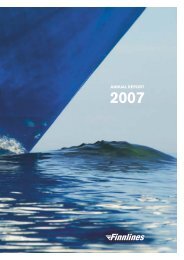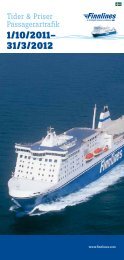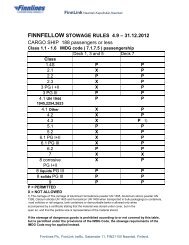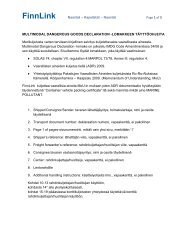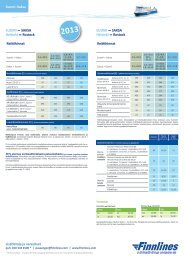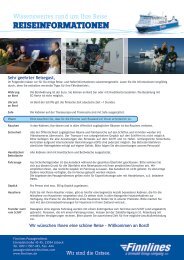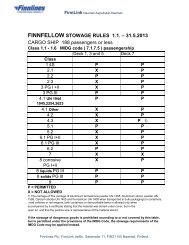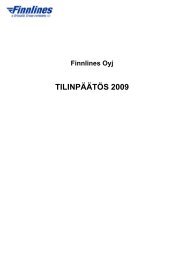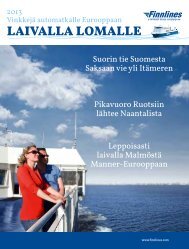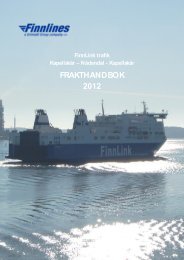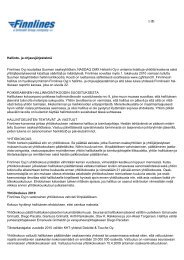FINANCIAL STATEMENTS 2010 - Finnlines
FINANCIAL STATEMENTS 2010 - Finnlines
FINANCIAL STATEMENTS 2010 - Finnlines
You also want an ePaper? Increase the reach of your titles
YUMPU automatically turns print PDFs into web optimized ePapers that Google loves.
NOTES TO THE CONSOLIDATED <strong>FINANCIAL</strong> <strong>STATEMENTS</strong><br />
1. CORPORATE INFORMATION<br />
<strong>Finnlines</strong> is one of the largest North-European liner shipping<br />
companies, providing sea transport services mainly in the Baltic<br />
and the North Sea. In addition to freight, the company's ro-pax<br />
vessels carry passengers between five countries and eight ports.<br />
The company also provides port services in Helsinki, Turku and<br />
Kotka. <strong>Finnlines</strong> has subsidiaries or sales offices in Germany,<br />
Belgium, the UK, Sweden, Denmark and Poland and a repre-<br />
sentative office in Russia.<br />
The Group's parent company, <strong>Finnlines</strong> Plc, is a Finnish pub-<br />
lic limited company, which operates under Finnish jurisdiction<br />
and legislation. The parent company is registered in Helsinki at<br />
Porkkalankatu 20, 00180 Helsinki. Copies of financial statements<br />
can be obtained from www.finnlines.com or the company's head-<br />
quarters. These financial statements were authorised for issue<br />
by the Board of Directors of <strong>Finnlines</strong> Plc on 2 March 2011. In<br />
accordance with the Finnish Companies Act, the financial state-<br />
ments are presented for approval to the Annual General Meeting.<br />
2. ACCOUNTING PRINCIPLES<br />
BASIS OF PREPARATION OF THE <strong>FINANCIAL</strong> <strong>STATEMENTS</strong><br />
The consolidated financial statements are prepared in accord-<br />
ance with the International Financial Reporting Standards (IFRS),<br />
using the IAS and IFRS standards and SIC and IFRIC interpreta-<br />
tions valid on 31 December <strong>2010</strong>. The International Financial Re-<br />
porting Standards mean the standards implemented in the EU by<br />
Regulation (EC) 1606/2002, and the related interpretations. The<br />
notes to the Consolidated Financial Statements also comply with<br />
Finnish accounting and corporate legislation. The Consolidated<br />
Financial Statements are primarily prepared using the acquisition<br />
cost method. Exceptions to this principle are financial assets and<br />
liabilities recognised at fair value through profit or loss.<br />
IMPLEMENTATION OF STANDARDS<br />
New and amended standards adopted in <strong>2010</strong><br />
The following new and revised IFRSs have been adopted in<br />
these consolidated financial statements. The application of these<br />
new and revised IFRSs have not had any material impact on the<br />
amounts reported for the current and prior years but may affect<br />
the accounting for future transactions and events.<br />
• Revised IFRS 3 Business Combinations (issued in 2008)<br />
and consequential amendments to IAS 27, Consolidated<br />
and separate financial statements, IAS 28, Investments<br />
in associates, and IAS 31, Interests in joint ventures, are<br />
effective prospectively to business combinations for which<br />
the acquisition date is on or after the beginning of the first an-<br />
nual reporting period beginning on or after 1 July 2009. The<br />
revised standard continues to apply the acquisition method<br />
to business combinations but with some significant changes<br />
compared with IFRS 3. For example, all payments to purchase<br />
a business are recorded at fair value at the acquisition date,<br />
with contingent payments classified as debt subsequently re-<br />
measured through the statement of comprehensive income.<br />
(figures in EUR thousand, if not stated otherwise)<br />
There is a choice on an acquisition-by-acquisition basis to<br />
measure the non-controlling interest in the acquiree either<br />
at fair value or at the non-controlling interest's proportionate<br />
share of the acquiree’s net assets. Further, under the revised<br />
standard all acquisition-related costs will be expensed.<br />
• Amended IAS 27 Consolidated and Separate Financial<br />
Statements (issued in 2008). The standard requires the ef-<br />
fects of all transactions with non-controlling interests to be<br />
recorded in equity if there is no change in control and these<br />
transactions will no longer result in goodwill or gains and loss-<br />
es. The standard also specifies the accounting when control<br />
is lost. Any remaining interest in the entity is re-measured to<br />
fair value, and a gain or loss is recognised in profit or loss.<br />
• Amendment to IAS 39 Financial Instruments – Recognition<br />
and Measurement – Eligible Hedged Items. The amend-<br />
ment provides clarification on identifying inflation as a hedged<br />
risk and on hedging with options.<br />
• IFRIC 17 Distribution of Non-cash Assets to Owners. The<br />
interpretation provides guidance on the appropriate account-<br />
ing treatment when an entity distributes assets other than<br />
cash as dividends to its shareholders.<br />
• IFRIC 18 Transfers of Assets from Customers. The interpre-<br />
tation addresses the accounting by recipients for transfers of<br />
property, plant and equipment from customers. This interpre-<br />
tation clarifies the requirements of IFRSs for agreements in<br />
which an entity receives from a customer an item of property,<br />
plant and equipment, or cash to acquire such item, that the<br />
entity must then use either to connect the customer to a net-<br />
work or to provide the customer with ongoing access to sup-<br />
ply of goods or services (such as supply of electricity, gas or<br />
water).<br />
• Amendments to IFRS 2, Share-based payment – Group<br />
Cash-settled Share-based Payment Transactions. The<br />
amendments clarify the scope of IFRS 2.<br />
• Improvements to IFRS (April 2009). In the annual im-<br />
provement process IASB deals with non-urgent but neces-<br />
sary amendments to IFRS, which are collected and issued<br />
annually.<br />
Implementation of new and revised standards and interpreta-<br />
tions in future accounting periods<br />
IASB has published the following new or revised standards and<br />
interpretations which the Group has not yet adopted. The Group<br />
will adopt each standard and interpretation as from the effective<br />
date, or if the effective date is other than the first day of the re-<br />
porting period, from the beginning of the next reporting period af-<br />
ter the effective date. The application of these new IFRSs are not<br />
estimated to have a material impact on the amounts reported for<br />
the future periods except for the application of IFRS 9 for which<br />
the management has not yet estimated the possible impact.<br />
• Amendment to IAS 32 Financial Instruments: Presentation<br />
– Classification of Rights Issues (effective for reporting pe-<br />
riods beginning on or after 1 February <strong>2010</strong>). The amendment<br />
FINNLINES PLC Financial Statements <strong>2010</strong><br />
11



